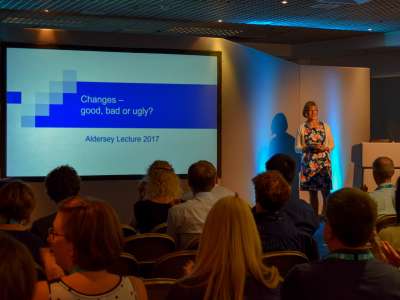
As an occupational therapist with six months’ experience working in a wheelchair service, and being a first-time attendee at the PMG Conference 2017, my initial impression was the diversity of topics covered at the event. Medical, technological, personal and service level issues were all debated and discussed but, ultimately, the theme that ran through all of them was maintaining a person-centred approach. I learned that one of the greatest skills a wheelchair clinician can have is to achieve the balance between a person’s goals and functional aims, their postural/mobility needs, and the equipment that can help realise these.
The event displayed a wide range of technological innovation both in the exhibition and in the proceedings. Some of the technology is being developed to help service users manage aspects of their own needs, for example the Invacare Lynx controller which allows wheelchair users to monitor the performance of their chair, and the prototype Sunrise backrest being tested to regulate temperature. I also attended the session about the intensive home-based manual wheelchair computer training, developed to increase wheelchair skills and promote independence. I shall take this new awareness of developing technologies back to my workplace, and consider them when assessing clients.
It was inspiring to hear from Lone Rose in the Aldersea Lecture that, although change is inevitable in any field, the issues that wheelchair users want to overcome have always been the focus for clinicians. Even as wheelchairs and seating systems become increasingly sophisticated, the postural principles underpinning them remain the same, and the goal is always individual client satisfaction. (Photograph shows Lone Rose presenting the Aldersea Lecture 2017). The many debates I observed amongst clinicians led me to realise that there is often more than one answer when considering the “best fit” within specialist seating. Furthermore, many of the case studies highlighted the evolutionary nature of achieving and maintaining the balance between posture, individual function, and comfort.
I was interested to hear different professionals advocating collaboration between the technological innovators, researchers, medical professionals and therapists to achieve the greatest client outcomes. It was also exciting to see and learn about new products, and consider the clinical reasoning to advocate for these products for my clients. I learned that, quite often, those with technical knowledge of the products can make small adjustments to equipment to make it work for individual client need. As Pauline Pope (2007) stated “A disabled person may adopt a certain posture to optimise function” and therefore equipment may need to be adapted to accommodate this.
It was truly inspiring to hear wheelchair user Chris Rattenbury in the opening plenary session talking about his experiences with a message echoing the importance of person-centred provision. He was clear about what he needs from his wheelchair: it must support his active lifestyle and, although his wheelchair provides essential mobility, this is always secondary to the activity it allows him to participate in. Posture and mobility are always important and, when impaired, can limit function, but an individual’s functional goals and participation should not be compromised unnecessarily in pursuit of optimising posture. As an occupational therapist, this is a focus I would like to maintain in my future practice.
However, I also learned about the importance of 24-hour postural management and the impact that deformation can have on seating ability, pressure ulcer risk and function. In my ongoing practice, I will have greater awareness of the negative effects of gravity on posture, and how to minimise the effects of this.
Since attending the PMG Conference, I have a renewed enthusiasm for achieving the best outcomes for my clients, and I hope the knowledge I gained there will enable me to sustain a more person-centred approach.
References
Pope, P., 2007. Severe and Complex Neurological Disability. London: Butterworth- Heinemann Elsevier






.jpg)



no comments
Add your comment...